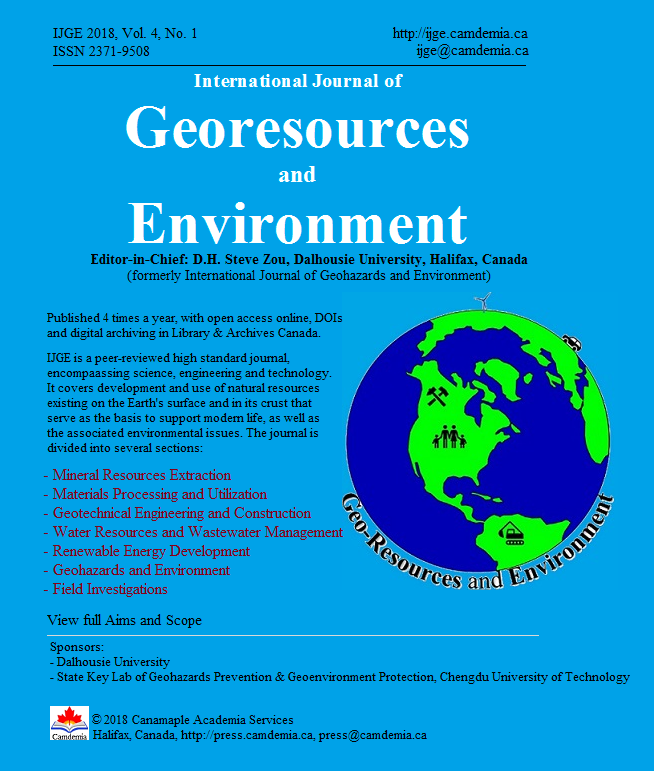Pollutants Removal Performance of Modified Constructed Rapid Infiltration System at Low Temperature
DOI:
https://doi.org/10.15273/ijge.2018.01.003Keywords:
low temperature, modified constructed rapid infiltration system, pollutants removal, COD, nitrate nitrogen, total nitrogenAbstract
The conventional Constructed Rapid Infiltration (CRI) system has a low removal rate for total nitrogen, although it has good removal effects on organic pollutants, ammonia nitrogen, suspended solid, etc. To improve the nitrogen removal performance of CRI system, two modified simulated columns were constructed in laboratory. The results in the domestic sewage treatment tests for these two modified systems was compared with conventional system. The system with the addition of an anaerobic saturated water layer only can increase the total nitrogen removal from 22.14% to 32.13% compared with the conventional system, however it contributes little to Chemical Oxygen Demand (COD) removal. Whereas in the system which is added with an anaerobic saturated water layer and extra carbon source entrance at the bottom, the average concentration of COD is decreased to 7.78 mg/l in the effluent wastewater, which is about 21 mg/l less than that of conventional column. The average removal rate of total nitrogen is increased to over 62%, which is almost three times that of the conventional system and two times that of the system with the addition of anaerobic saturated water layer only. Moreover, its average concentration of nitrate nitrogen is significantly decreased in the effluent wastewater. The improved pollutant removal of the system added with anaerobic saturated water layer and extra carbon source entrance resulted from the anaerobic environment, carbon sources and time for nitrate retention which are essential to denitrification.Downloads
Issue
Section
License
Copyright, Terms and Conditions
The International Journal of Geohazards and Environment (the Journal) is published by Canamaple Academia Services (the Publisher) online with open access, under a Creative Commons Attribution-Noncommercial license (CC-BY-NC) (http://creativecommons.org/licenses/by-nc/4.0/). Authors (the Authors) submitting papers (the Work) for publication in the Journal automatically agree to the following terms and conditions.
1. Under the license (CC-BY-NC), Authors give permission for others to share and reuse the Work, as long as the original source and author(s) are properly cited (i.e. a complete bibliographic citation and link to the Journal website) and the material is not used for commercial purposes. Any sharing or reuse must however indicate the original CC-BY-NC license terms of the work.
2. Authors transfer and assign to the Publisher all copyright in and to the Work. However Authors retain all proprietary rights except the copyright, related to the Work and also retain the rights a) to use, reproduce, distribute, and publicly display the Work in any medium in connection with the Authors‘ academic and professional activities, such as teaching, presentations and lectures, b) to create derivative works from the Work and to make full use of the Work in future research and publications, c) to authorize others to make any non-commercial use of the Work, d) to make both the pre-published and final-published versions available online in institutional and/or disciplinary repositories or on their own websites with a citation and link to the original paper published in the Journal.
3. Authors warrant that the Work is their original work, it is not copied from anywhere or anyone else, they are totally responsible for the authenticity, originality, validity and accuracy, and the facts and views are their own, that the Work contains no matter which is defamatory or infringes any literary or proprietary rights, intellectual property rights, or any rights of privacy, and that the Work has not been simultaneously submitted to any other journals or publishers. Authors further agree that their manuscripts whether accepted or rejected will not be returned and the rejected manuscripts will be disposed at the journal editor's discretion.
Disclaimer: The Publisher, the Journal and the editors accept no responsibility for statements or opinions expressed by authors. Use of information and materials in the Journal is the sole responsibility of users.


